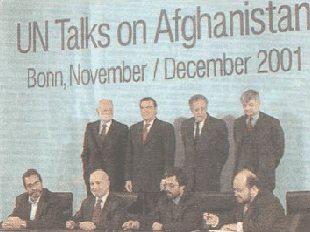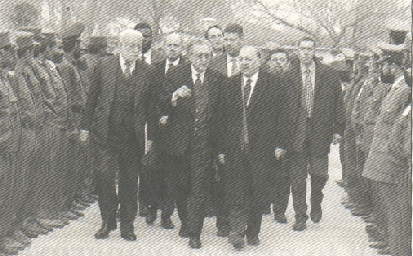Rebuilding Afghanistan
The new Afghan leader Hamid Karzai has promised to end the strife that
in two decades reduced Afghanistan to ruins and sucked in the armies of
superpowers. Mr. Karzai’s government has been charged with rebuilding
the war-shattered country after the overthrow of its former Taleban rulers.
The United Nations, leading reconstruction efforts in Afghanistan which
could cost up to $25 billion, has no illusions about the scale of the
task. “This is a failed state. Everything has collapsed. It is a
country that has been devastated by 23 years of unrelenting conflict,”
said Yusuf Hassan, senior UN spokesman in Kabul. “Much of the infrastructure
is in ruins. Roads, institutions, central bank, everything has to be rebuilt
from scratch. There is not a country in the world comparable in terms
of the destruction,” he added
 In the
capital Kabul, the most developed part of the country, beggar children
and women dressed in rags roam the streets. Private employment is virtually
non-existent, apart from a handful of international bodies and NGOs. Civil
servants have not been paid for months, leaving shopkeepers and traders
the only ones able to eke out a living. In the country as a whole, ravaged
by drought in recent years, subsistence agriculture dominates the landscape,
encouraging farmers increasingly to grow poppy fields for the heroin trade
now that the Taleban ban on poppy cultivation has gone
In the
capital Kabul, the most developed part of the country, beggar children
and women dressed in rags roam the streets. Private employment is virtually
non-existent, apart from a handful of international bodies and NGOs. Civil
servants have not been paid for months, leaving shopkeepers and traders
the only ones able to eke out a living. In the country as a whole, ravaged
by drought in recent years, subsistence agriculture dominates the landscape,
encouraging farmers increasingly to grow poppy fields for the heroin trade
now that the Taleban ban on poppy cultivation has gone
Four to five million refugees – a quarter of the
population – are living mainly in Pakistan and Iran. They include
many of the best educated who fled during the ten-year Soviet occupation
and the subsequent civil war. Nation building has to start virtually from
scratch. But even before that, large areas have to be cleared of landmines
and unexploded bombs in order to improve safety and security of both Afghans
and foreign aid workers. The next stage would involve laying new roads
and townships, restoring electricity and water supplies, equipping hospitals
and schools, and establishing a telecommunications network. None of this,
however, would be possible if the various factions fall out over power
and revenue sharing. In a sense, therefore, the end of the Taleban saga
is just the beginning of a new chapter in Afghanistan’s history.
East Timor can serve as model: UN
 UN Secretary-General Kofi
Annan said a day after receiving the 2001 Noble Peace Prize in Oslo that
Timor may be a tiny model for rebuilding shattered Afghanistan. “There
are similarities in what we found in East Timor in November 1999 and what
the new interim administration in Kabul will have to deal with,”
he told a news conference in Oslo. The World Bank and United Nations said
in a report unveiled in Brussels recently that Afghanistan would need
$9 billion in aid over the next five years to rebuild after two decades
of war
UN Secretary-General Kofi
Annan said a day after receiving the 2001 Noble Peace Prize in Oslo that
Timor may be a tiny model for rebuilding shattered Afghanistan. “There
are similarities in what we found in East Timor in November 1999 and what
the new interim administration in Kabul will have to deal with,”
he told a news conference in Oslo. The World Bank and United Nations said
in a report unveiled in Brussels recently that Afghanistan would need
$9 billion in aid over the next five years to rebuild after two decades
of war
Donor countries have pledged $660 million in aid to the
United Nations to help Afghanistan for the six months to March, but UN
officials say the nation will need at least $660 million more from March.
The long-term process of rebuilding could cost $10 billion over 10 years,
according to one British aid official. The Commissioner of the European
Union, Paul Nielson, has said the European Union was ready to assist the
new government in Afghanistan and play its role in the reconstruction
of the war-ravaged country. Mr. Nielson said demining activities were
among their priorities and the EU had decided to fund some capacity-building
programmes from a very early stage in Afghanistan. “The biggest share
in Afghanistan will be ours,” he said. Meanwhile some wealthy and
well-educated Afghans who have lived outside their country for years have
expressed their readiness to abandon their prosperous lives in the West
and return to rebuild their country.









